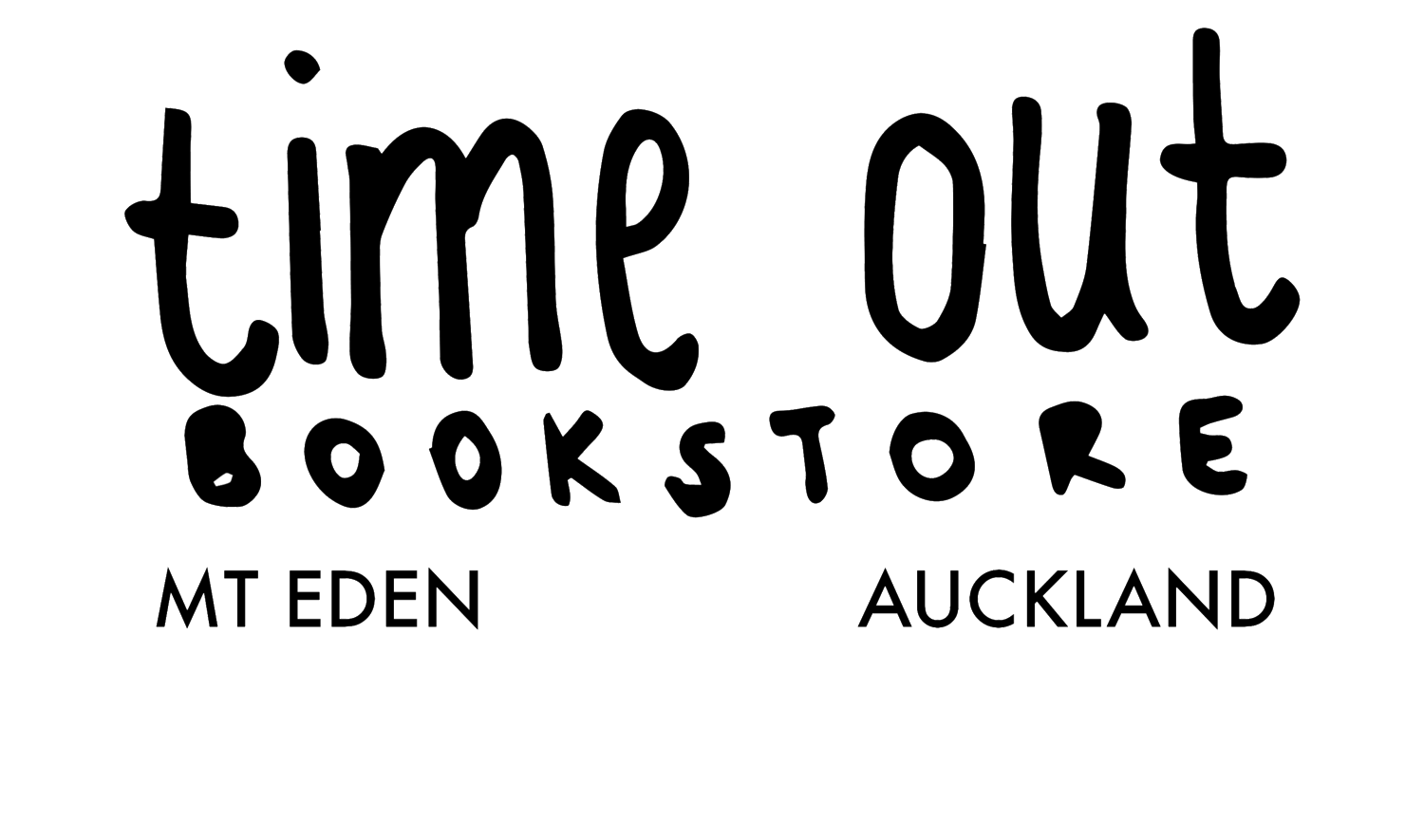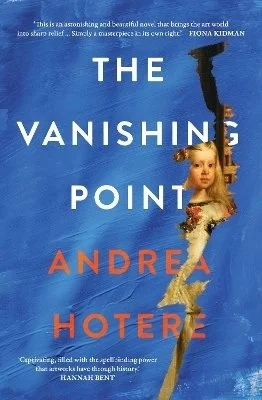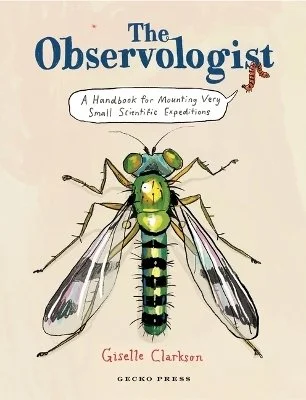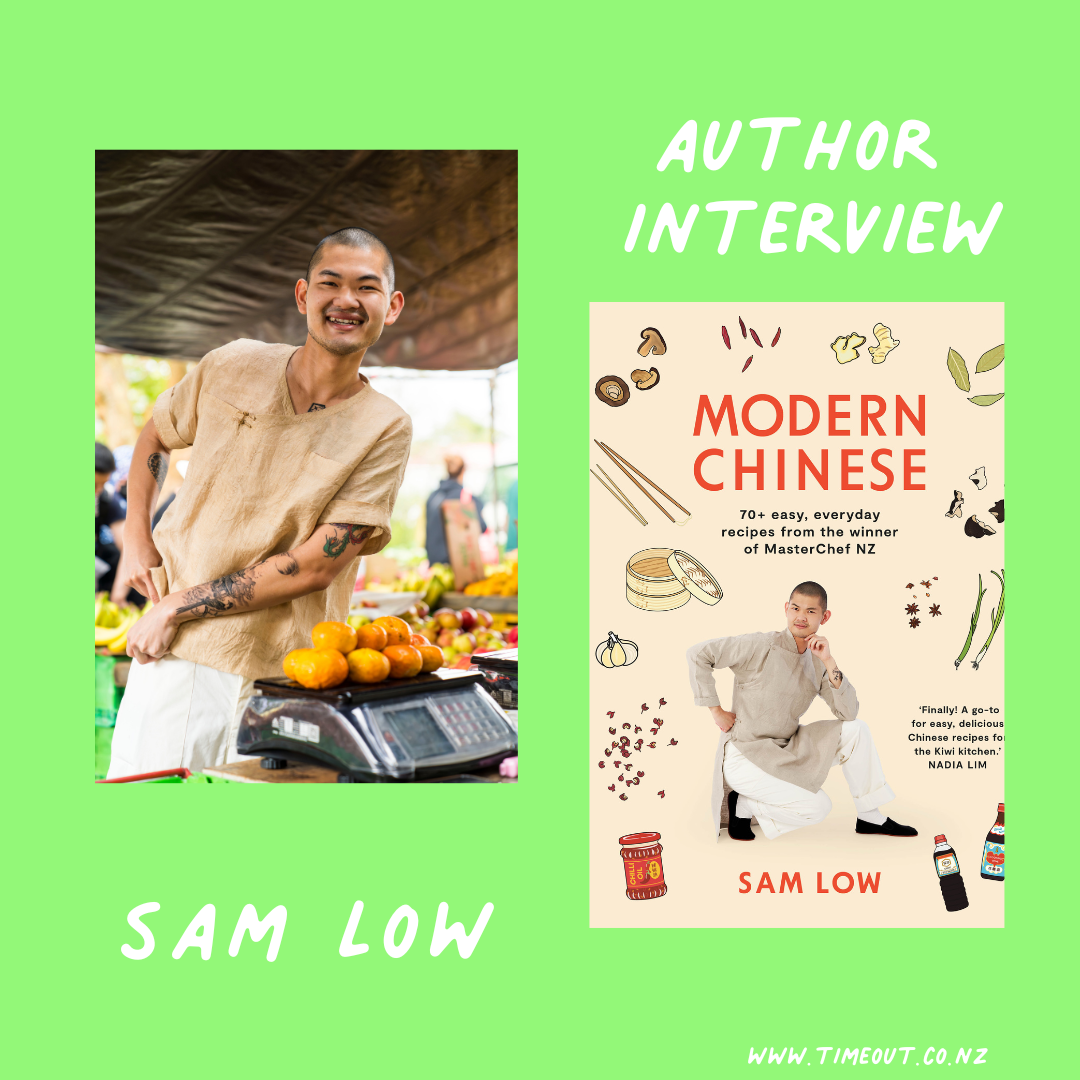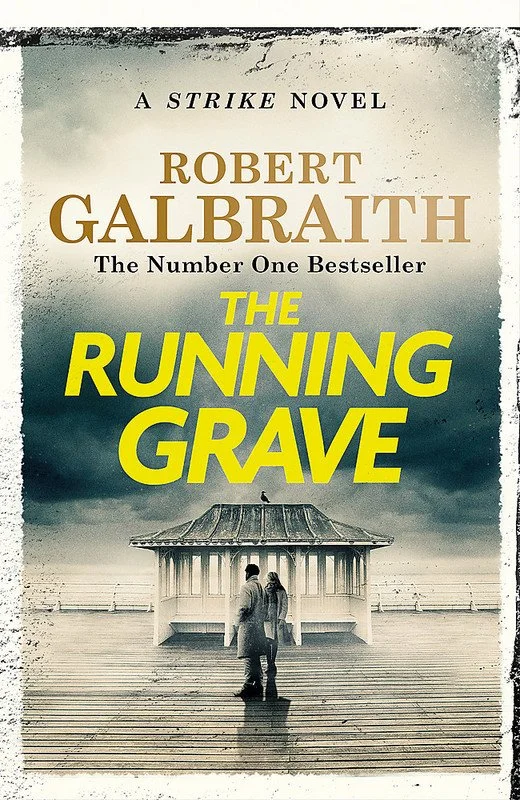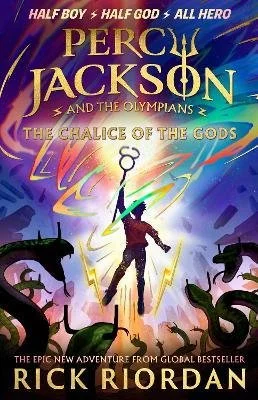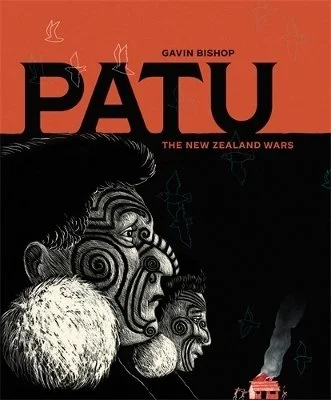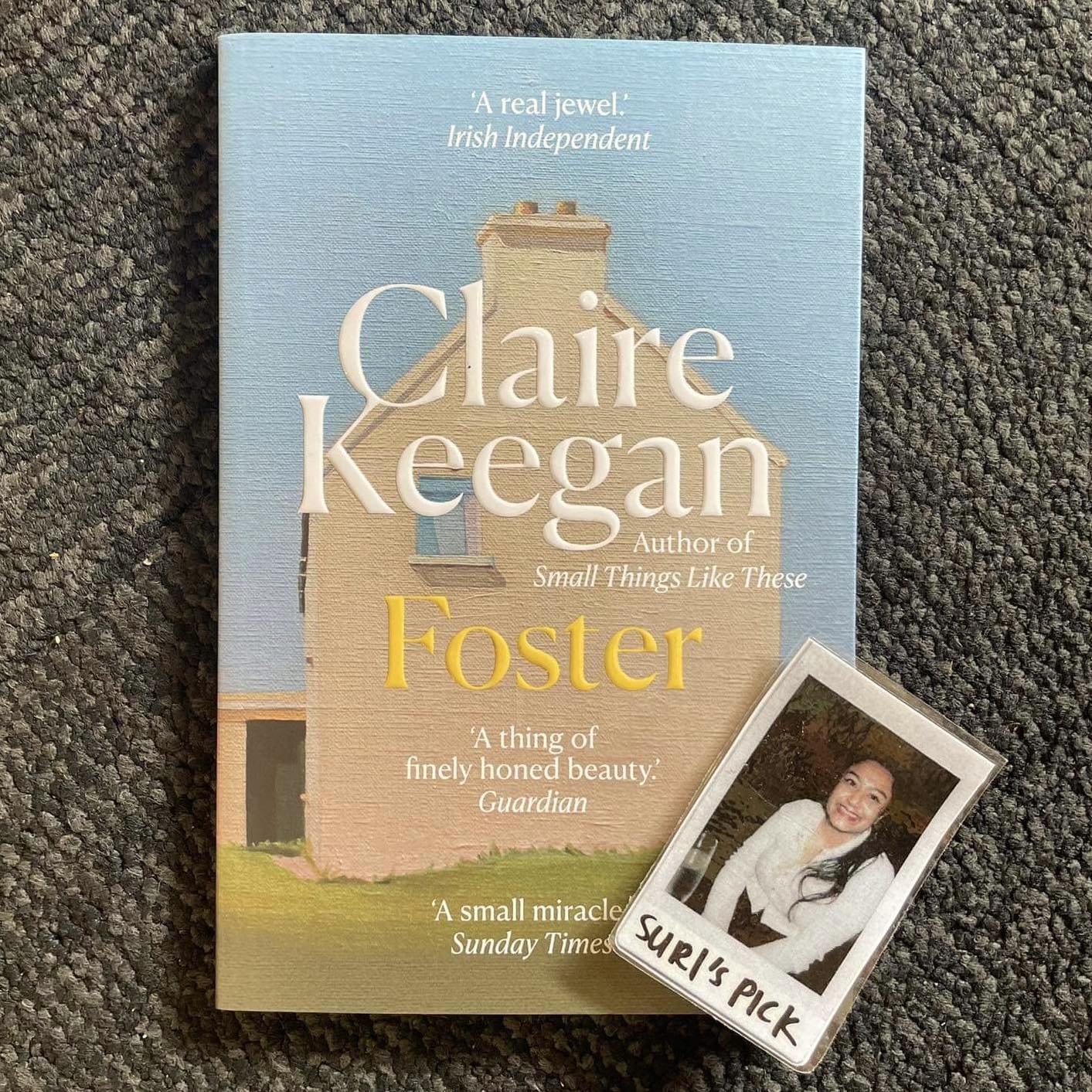Our top 10 bestselling books of the year.
95bFM's Loose Reads: Prophet Song by Paul Lynch + Christmas agony aunt /
Jenna brings in the recently minted 2023 Booker winner, Prophet Song by Paul Lynch. A powerful, gut-punch of a book, set in modern day Ireland - following a mother of four as she desperately tries to keep her family together during a civil war.
Jenna, Rachel & Stella also some Christmas agony aunt questions!
Wafting 95bFM listener: The Vulnerables by Sigrid Nunez or Sonic Life by Thurston Moore.
Big reader aunt: The Postcard by Anne Berest
Tween read: Impossible Creatures by Katherine Rundell
Also! Don’t forget to get tickets to the Save the B gig. This Wednesday, 20th December.
95bFM's Loose Reads: Suri's Christmas picks! /
Suri is in the studio today with her picks for Christmas.
Pacific Arts Aotearoa ed. by Lana Lopesi
So Late in the Day by Claire Keegan
Rapture: An Anthology of Performance Poetry from Aotearoa New Zealand ed. by Carrie Rudzinski & Grace Iwashita-Taylor
Wolves of Eternity by Karl Ove Knausgaard
Rick Stein's Simple Suppers by Rick Stein
Listen to her kōrero with Rachel and Stella below for the hot tips.
Bestsellers for November 2023 /
95bFM's Loose Reads: Bird Life by Anna Smaill /
Bird Life is a lyrical, present novel set in Japan. Dinah, grieving the suicide of her twin brother, moves from Aotearoa to Japan to teach English. There, she meets Yasuko, a mother grieving her son leaving home. Together, the kinship between Dinah and Yasuko deepens as they navigate their own paths.
Listen to Jenna’s on studio chat with Rachel and Stella below.
95bFM's Loose Reads: Baumgartner & A Thread of Violence /
Suri reviews two books on 95bFM’s Breakfast show today.
In A Thread of Violence, Mark O’Connell revisits a close to home in Dublin. A dramatic true crime featuring interviews with the killer.
Baumgartner by Paul Auster tells the story of Cy, a widower moving through domestic activities. Filled with human moments that are told with the ghost of his wife in mind.
You can listen below!
Author Interview: Sam Low - Modern Chinese /
Hollie spoke to MasterChef winner Sam Low about his amazing new cookbook, Modern Chinese.
What does a typical day look like for you?
The great thing about being a freelancer and a food creative means I have the opportunity to dabble in so many different areas within food media. If i'm not doing my brand ambassador work (which includes recipe development, video shoots or workshops) I am either creating content for social media or working on a creative food project, an example of this was earlier this year I was a part of a team helping to develop a food theater show and hosting Sik Fan Lah a food adventure series on TVNZ. I’m currently brewing a new project so watch this space!
What was the process of getting your cookbook published?
Long, cathartic and thought provoking would be some of the words to describe the process. I looked into so many different aspects of food media exploring things like food masculinity, orientalism in food photography, queer food history, Chinese gastronomy, assimilated Chinese food (survival Chinese food), my relationship to food and family, these were just some of the topics I looked into. I thankfully had the best publishing team that helped me throughout, and because it is the first of its kind in NZ and the only Chinese cookbook to come out in the last decade we were all piecing it together and learning from the process. It starts with writing recipes that utilize a really accessible and approachable pantry which is a section in the book I spent a lot of time on. The recipes needed to be cohesive to a Chinese banquet meaning that there are options for protein or vegetable focused dishes including rice, noodles, broths and cold appetizers. Once the recipes were done, its recipe testing and food photography. From here, essays, stories, illustrations and personal touches. Once everything is designed then we think about the title and final checks before it goes off to print.
Why did you decide to do Modern Chinese as a cookbook?
I felt as though in NZ there aren’t many books focused around diasporic foods or speak to the history of food from ethnic minorities that help make up the beautifully diverse culinary scene here in Aotearoa. Modern Chinese is a documentation of something that is important to the food scene here and speaks to the contemporary audience of today, hoping to debunk any xenophobia people might have on Chinese cuisine. I wanted to create a cookbook that is easy, accessible, approachable and targeting a large audience potentially first time cookbook owners. Modern Chinese is about community and a simple introductory guide into Chinese food and culture, hoping to inspire young cooks, food creatives and other diasporic communities to embrace and celebrate their own cuisine and share their love of food.
Do you have a favourite recipe in the book?
Instead of my favourite recipe, my favourite part of the book is the building of the pantry. I have arranged this section into 3 tiers, tier one being super easy to access even from a western supermarket and with that alone you can create most of the dishes in the book. I wanted the book to be utilised throughout with a simple Chinese pantry so specialty ingredients that are not only used once and sit at the back of the pantry. Outside of ‘the building of the Chinese pantry’ my favourite recipes are the sauces in the book, they help make bland foods super tasty! Like the sweet fragrant soy sauce (make a batch and store in squeezy bottles) and the aromatic chilli oil (also make batches and store in jars). Use these on a simple protein like grilled chicken on rice, add it in a stir fry or dressing your dumplings, these homemade condiments are game changers.
What is one ingredient that you always have on hand?
Besides the homemade condiments, I might say ground white pepper. It's floral, warmingly spicy and can be used in every savoury dish. If this is new to you, start adding a little shake (or pinch) in your savoury foods to add a new level of flavour.
What food writers inspire you?
Fuchsia Dunlop is a big one for me, a Chinese food gastronomist, a wealth of knowledge matched with an infectious love and appreciation for the people, culture and food of China. Soliel Ho, they were the head food critic at San Francisco’s The Chronicle now critic at large. I fell in love with Soleil’s work when they did the podcast Racist Sandwich and Extra Spicy, having different narratives and conversations in food media about class, race and gender. Brandon Jew, owner of Mister Jiu’s in San Francisco's Chinatown, a Michelin star modern Chinese restaurant. Brandon really pushed the boundaries of what it means to be Chinese American where you don’t need to be more or less Chinese to feel enough as a Chinese person in diaspora. Harold McGee, an American author who writes about science and food but his latest work on smell has really changed the way I think about our human senses. His book ‘Nose Dive’ a field guide to the world of smells is so incredible it goes beyond food but more so on how we navigate life.
What author or book is a recent discovery for you?
Emily Contois is an incredible author whom I discovered last year. She’s an associate Professor of Media Studies at The University of Tulsa, author of Diners, Dudes & Diets: How Gender & Power Collide in Food Media & Culture, and co-editor of Food Instagram: Identity, Influence & Negotiation. Her work revolves around food media and how it has come to be in today’s climate. I am especially interested in her exploration of the ways we consume food media and how this reflects on our day to day food behaviors in society.
What was your favourite snack to eat while putting together Modern Chinese?
Soft egg (slightly scrambled and folded) sandwiches with Japanese mayonnaise. The soft white loaf bread and delicate sweet egg is so comforting and has been a favourite of mine growing up since a little kid.
95bFM's Loose Reads: Three Nice Novels /
It’s almost Christmas, therefore it’s time for our end of year round-ups. Today, Jenna chose three nice novels, just because it feels like we need them.
Tom Lake by Ann Patchett
Good Material by Dolly Alderton (audiobook on Libro.fm)
Welcome to the Hyunam-Dong Bookshop by Hwang Bo-Reum
Listen to Jenna’s on studio chat with Rachel and Stella below.
RNZ's Nine to Noon: The Bee Sting by Paul Murray /
Today on Nine to Noon, Jenna chatted to Susie about The Bee Sting. This has been shortlisted for the Booker, which will be announced in just over a week!
A supremely Irish tragi-comedy, this is Jenna’s favourite novel of 2023.
Listen below for the full review.
95bFM's Loose Reads: Rapture: An Anthology of Performance Poetry from Aotearoa New Zealand /
Rapture - a brand new Auckland University Press anthology, edited by Carrie Rudzinski and Grace Iwashita-Taylor, is one for the home library.
Listen to Suri wax lyrical about this collection to Rachel, as well as read out a poem by our very own staff member, Abby Irwin-Jones.
Author Interview: Mona Awad - Rouge /
Hollie spoke to best-selling author and store favourite, Mona Awad about her latest novel, Rouge.
Where do you draw inspiration from?
Usually my own fixations and obsessions. In the case of Rouge, it was skincare and beauty, and an addiction to beauty videos on YouTube. I couldn't help but see the great potential for horror there. I'd also always wanted to work with the fairy tale of Snow White, which is the ultimate fairy tale about beauty and its shadow side.
So….Tom Cruise?
Or is he? Appearances can be deceiving, Bunny :)
Has your skincare routine changed since writing Rouge?
It was really byzantine when I first became obsessed with skincare and I experimented quite a bit with different products. I was also very easily enchanted and seduced. Now I have some trusted products I rely on and I'm slightly more dubious of claims. But I'll always love a mist and to be honest, I'm still a bit of a sucker.
What’s next in skincare?
God knows. But I'll probably be trying it.
How do you structure the layout of a story? Do you write with an outcome in mind?
Usually I'll do a kind of rough blueprint of the first part of the book and then I'll start writing. The ending usually comes to me as I'm writing the beginning. I don't hold myself to it, I tend to just follow the story, but in each case it's where the book has wanted to land.
There are aspects of your novels that read like a dream. Are any parts of your books inspired from a dream you’ve had?
I'm glad to hear that. I think that's often the feel that I'm going for and the subject matter or the character's mental state is what dictates it. Beauty is, after all, a kind of dream. I also really like to immerse the reader in the character's mind, and in our minds we're always dreaming.
What author or book is a recent discovery for you?
Not terribly recent, but I really loved Piranesi by Susanna Clarke. I thought the narration was so wonderful--this heady mix of enchantment and dread.
What is your favourite snack to enjoy while writing?
Usually it's just coffee or green tea for me but I have a friend who sends me little knick knacks that are in conversation with whatever book I'm working on, sort of to cheer me on. For Rouge, she bought me these beautiful rose gummies. I did enjoy those during breaks.
95bFM's Loose Reads: The Woman in Me by Britney Spears /
It’s Britney, bitch!
Jenna thoroughly enjoyed Britney’s highly anticipated and bestselling memoir. With the perfect mix of shock, sadness, humour and plenty of villains., The Woman in Me gives a lot of insight and context into the dark side of fame.
This was listened to on Libro.fm, where your chosen indie bookshop gets a portion of the sale.
Listen to Jenna’s on studio chat with Rachel and Stella below.
Bestsellers for October 2023 /
95bFM's Loose Reads: Foster by Claire Keegan /
In anticipation of Claire Keegan’s new novella, Suri delved into Foster.
Purposefully told, this is a tale of beauty with an underlying dark backstory. Touching, beautiful and a great distraction from studying for exams.
So Late in the Day is due next month.
Suri called into the studio to chat to Rachel.
Author Interview: Dominic Hoey - Poor People With Money /
Hollie spoke to award-winning poet and playwright Dominic Hoey about his latest novel, Poor People With Money. This is a pacy, heart-twisting, punch-in-the-guts, darkly comic novel that captures life on the poverty line in Aotearoa now.
What does a typical day look like for you?
I normally wake up around 10 or 11, argue with Chilli (my dog), go to work at Atawhai and look after teenagers, come home, more arguing with Chilli. Around 10ish I start writing then when that becomes hopeless I read or watch a film. There's also drinking and talking shit with friends mixed in there.
Where did the inspiration for Poor People with Money come from?
I wanted to write about the shit people have to do just to get a pinch of dignity when you're broke. Also I used to train Muay Thai before I got sick and I always thought that combat sports in general is such an interesting community.
What is one thing you would like readers to take away from Poor People With Money?
I don't know if there was a moral I wanted people to get. Just hopefully it inspired people to write. Like if a dyslexic with no education can do it so can you.
How did your writing workshops come about?
When I was 18 I was in the dole office and they were like "what do you want to do?" and I kept on saying I wanted to be a writer. Which they must have thought was crazy. but I had a case worker who actually tried to find me short courses but there wasn't really anything. So once I learnt some stuff I really wanted to share this knowledge with people. especially people who wouldn't normally have access to it.
Do you have a different approach when it comes to writing a poem versus a novel?
Yeah its a real different part of the brain. I feel like poetry is squinting and looking at a photo and then describing it, where's a novel is a pile of photos you're trying to arrange into a story.
What can you tell us about your next novel?
I'm currently writing two. One is set over a month starting the day after the rainbow warrior bombing in 1985. It's about a thieving fat kid who's really good at video games. The other one is a paranormal mystery thriller set in Port Chalmers.
What is your favourite snack to enjoy while writing?
I don't really eat when I write. I smoke lots of weed when I write poetry. It doesn't help with novels though unfortunately
What author or book is a recent discovery for you?
I've recently got into Dan Chaon who writes quite dark kind of mysteries I guess. But they are more about families and breakdown of relationships. Also Night Boat to Tangier by Kevin Barry. One of the best books I've ever read
Can we expect Prince Chilli’s memoir anytime soon?
Yes, in fact the final draft of "Biting My Way To Happiness" is with Penguin as we speak
Author Interview: Ruin and Other Stories - Emma Hislop /
Hollie spoke to Emma Hislop about her debut collection, Ruin and Other Stories. This collection shimmers with a brutal kind of hope, exploring power and its contortions, powerlessness and its depravities, and the ends to which we will go to claim back agency.
Tell us about yourself.
I whakapapa to Kāi Tahu. I love coffee and good books and spending time with my loved ones. I'm trying to write a novel now. I live in Taranaki with my partner and kid and dog. I currently am trying to make a living freelancing and juggling lots of jobs.
What are you currently reading?
Hiwa, the new collection of contemporary Maori short stories. It’s out with AUP and it’s a beautiful thing.
What inspired the collection?
I’ve always been interested in power and the different forms it can take. The way in which it can be upfront and obvious, or more subtle and coercive. That’s Ruin’s main preoccupation, probably.
What was the intention in naming the collection Ruin?
II like how Ruin can be both an end and also hold potential. The stories in this collection can be hard to read at times, but hopefully, by shining a light on them, some of the power is taken out of some of the violence that’s in them.
How did you go about choosing the cover art by Maiangi Waitai?
I’ve admired Maiangi’s work for years, and when I saw this image, which is titled ‘When pushed, pull’, it seemed to encapsulate the ideas I was trying to express in my writing. It’s both chaotic and full of potential. The publishing team at Te Herenga Waka went for it, luckily.
Do you have a favourite story from the collection?
That’s a hard question, but I think I’d choose The Game. I was interested in the power dynamic with the complicated friendship and it challenged me in terms of what each character knew or didn’t know about the situation. Also its set in summertime in Brixton, in South London where I lived for almost a decade.
How did you feel when you heard Ruin and Other Stories was going to be published?
I was happy! I’d hoped Te Herenga Waka would want it. I sent it there first as I’ve built up a bit of a relationship over the years.
What writing projects do you have in the pipeline?
I was fortunate to receive some CNZ funding last year to draft a novel, so I’ve been working hard on that. It’s set in Ōtepoti and I'm hoping to get back down there soon.
What is your favourite snack to enjoy while writing?
Honestly, as long as I have coffee and fizzy water, I’m good. I don’t really snack. Roasted almonds, if I can afford them.
Author Interview: Melinda Szymanik - Lucy and the Dark /
Hollie spoke to Melinda Szymanik about her latest children’s book, Lucy and the Dark. When Lucy makes friends with the Dark she discovers a new and exciting world - but the world is about to discover what it's like without the Dark! A funny and enjoyable bedtime story with a glow-in-the dark cover to encourage lights out!
Tell us about yourself.
People say we are made up of atoms, or cells, or flesh and blood, but personally I believe I am made up of words. When I first learned to read, I was filling up pretty fast on new words and I expanded exponentially till I became an adult. I have slowed down quite a bit now because I come across fewer previously unmet words, but I’ll keep growing till I die like a tortoise or nose hairs.
What inspired Lucy and the Dark?
I can’t remember, but whatever it was I’m really grateful because it turned out really well. However, as it is a bit rubbish to say, ‘I can’t remember,’ here is a snippet from an earlier draft, which ended up getting replaced as it didn’t fit so well with the rest of the story but is still rather lovely, I think.
‘It’s time to go home,’ I said.
I don’t want to go back to where everyone is afraid of me,’ Dark cried.
‘But I will be there,’ I said. ‘And we are the best of friends.’
‘But what do you see in me?’ Dark asked.
And I said, ‘The stars.’
What is something you are scared of?
Being buried alive. Not really a great central idea for a picture book though so I went with the dark instead which I’m only just a little bit afraid of.
How did you team up with illustrator Vasanti Unka?
When Penguin decided to publish my picture book My Elephant is Blue, they had the genius idea of inviting Vasanti to illustrate. She did an incredible job so when they suggested her for Lucy and the Dark, I could not have been happier. Dark is just so cute and charming children will be won over instantly.
Can you describe your writing space for us?
I have the terrible habit of writing in bed. I hear Meg Rosoff does the same so I feel like I’m in good company, but it really isn’t good for your back or neck. I can see Maungawhau/Mt Eden from my bedroom window plus our front garden, and the cat hangs out with me, and it is lovely and peaceful, and I am surrounded by all my own detritus which seems to support my creative process.
What are some of your favourite childhood books?
I will never get over Where the Wild Things Are by Maurice Sendak and The Lion in the Meadow by Margaret Mahy. They are magic and no matter how many times I read them I can’t quite see how the trick is done and I am delighted all over again. We should never stop reading picture books – they are the biggest source of wonder in literature.
What is your favourite snack to enjoy while writing?
I’m not much of a snacker when I write (do I even qualify as a real writer?).
Author Interview: Ruby Solly - The Artist /
Hollie spoke to Ruby Solly ahead of the release of her latest collection, The Artist. The Artist brings to life the histories of our great Southern iwi through the whakapapa of its characters and the rich world they and their ancestors call their tūrakawaewae—their place to stand, their place to sing.
Tell us about yourself.
Kia ora! Ko Ruby Solly tōku ikoa. Ko Waitaha ratou ko Kāti Māmoe, Ko Kāi Tahu ōku iwi. Ko Waihao tōku marae. My name is Ruby and I’m a proud daughter of our Southern iwi, hailing from Waihao marae. I’m a writer, taonga pūoro practitioner, music therapist, and general kaitoi living in Pōneke, Wellington. My second book ‘The Artist’ is out now from Te Herenga Waka University Press.
What first sparked your interest in Tarot?
Honestly, I’m not really a tarot reader! Huge interest, but I more read oracle cards and create similar sets to help me with randomizing content to generate inspiration. I’ve been interested in tarot since I was a kid when my parents gave me a book on magic and divination that had a paired down set in it which I would use. There’s a whakapapa connection with Judaism and tarok and other Jewish forms of divination and spirituality that come from our culture that we have taken with us across the world. I think the reading of tohu within my Māori whakapapa weaves in with this as well, and I see that reading of signs within our cave tohu, our cave art. When I make cards it’s often a way to represent options or trial things that I already have as strong themes within my mind, and it gives me a physical representation of my mental space. The character cards for the book were a big part of this; so I could randomize different relationships and think about dynamics and voices. It’s something that I’ve continued to use since this book, bringing it into my other work in music too!
What are the things that connect art, spirituality and whakapapa for you?
In a kind of weird and possibly narcissistic way, I think those things often combine within me, and within doing the work to create things from the whakapapa and connections to spirituality that it has. I also think just the idea of ceremony, and knowing that we can use our tikanga and kawa to create significant moments for ourselves spiritually, is crucial for me to create works like this and to ensure that it’s more than just me working. And to ensure I’ve got the strength to do it! I also think that art, spirituality, and whakapapa are truly in harmony for me when I’m on our whenua and working with our people with taonga pūoro. I truly believe that we can all create and being able to encourage that in other branches of my whakapapa is deeply meaningful for me.
There’s a mixture of prose, poetry and visual artistry in your poems and you’re also a songwriter! Do your creative processes inform one another?
I’m a firm believer that toi was and is something that weaves through all things and mediums. In secondary and tertiary spaces I was often ‘told off’ for ‘dabbling’ outside of whatever it was I was doing, and it took me a long time to decolonise this part of my thinking after having to partially adopt it in order to get through those places. Now, I use a wide range of creative mediums to bring out works. Sometimes I might create words, music, or art for a project, that doesn’t get used as part of the final piece and is just part of how I learn what I need to in order to create the work. The cards for this book were a bit like that, I didn’t initially think they would be in the book, but I’m so glad they are.
How did you approach writing The Artist?
With a lot of things I make, I get a very clear image of something within the work, and then I just can’t let it rest until I’m working towards that. For me it was one of the main characters, Te Heikiki, standing in a nightgown, bare foot on a dirt road, on a flat plain with wind stirring up her hair, which is how she appears on her character card too. After this, I did a lot of researching and having conversations with whanaunga and mentors about all the different aspects that went into the book; cave art, pūrākau, pounmu, whakapapa…. And then I planned out the plot in about 40 bullet points, and wrote to that! The first section took me a year because it covers the history of te Wai Pounamu up till settlement. Even though it’s only 12 or so poems, it really took a lot of research and thinking about wording. After getting that whakapapa sorted, it flowed so much easier from there.
What are some of your favourite writers or books?
Oh man, how many can I have? In Aotearoa, essa mae ranapiri, Tayi Tibble, Michelle Rahurahu ( who has an amazing novel coming out with THWUP), Whiti Hereaka, Becky Manawatu, Keri Hulme, Robert Sullivan, Albert Wendt, Kōtuku Titihuia Nuttal, Anne Kennedy, and you should definitely get my cousin’s book, ‘Bird Speak’ by Arihia Latham! Outside of Aotearoa, Joy Harjo, Anne Carson, ‘Deep Wheel Orcadia’ by Harry Josephine Giles, Faylita Hicks, Danez Smith, Bernadine Evaristo (check out ‘The Emperor’s Babe’), Leslie Marmon Silko, ‘The Golem’ by Gustav Meyrink, Alison Bechdel, Isabel Greenberg and Henry Dumas… amongst many others!
What is your favorite snack to enjoy while writing?
Currently a bit of cut fruit and some nuts as I’m on a diet for PCOS which affects the health and fertility of 10% of women, which isn’t something that we talk about a lot in society. But, this book was definitely written on date scones from Aro café. With the occasional eggs on toast, and always a mocha.
Author Interview: Joy Holley - Dream Girl /
Hollie spoke to Joy Holley about her latest release, Dream Girl. Bittersweet and intimate, comic and gothic, Dream Girl is a collection of stories about young women navigating desire in all its manifestations.
Tell us about yourself
I’m 25 and a lifelong Wellingtonian. I did my Masters at the IIML in 2020, and wrote most of the stories in Dream Girl that year. This is my first book.
What traits of a Virgo Sun, Sagittarius Moon, Taurus rising do you most possess?
Virgo Sun: I’m detail oriented (in writing and in life) and have a good memory for the specifics.
Sagittarius Moon: I love to party and I love to talk! Definitely an extrovert.
Taurus Rising: I feel very connected to all five senses. I’m obsessed with food and cooking, perfume and candles, pretty things, and soft clothing.
What inspired your short story collection, Dream Girl?
My friends, my crushes, and the queer community. I also wanted the book to reflect my aesthetic world, and contain lots of femme imagery. The stories are very much based in Wellington, and some were inspired by the history of specific places, such as Erskine College and Mount Victoria tunnel.
What was the intention behind the order of the stories in the collection?
The collection starts off pretty grounded in the real world, but most of the protagonists are living in a crush-related fantasy… they’re often a bit deluded. As the stories go on, the characters no longer get to live comfortably in their fantasies: love goes wrong, and the love-interests become less idealised. Meanwhile, the stories become more magical, and the supernatural creeps in. By the end of the book, there’s a broader sense of reality.
What author is a recent discovery for you?
I read Casey Plett’s short story collection A Dream of a Woman last year, and have read both of her other books since. Her work focuses on the lives of trans women, friendship, addiction, sex, and love. Highly recommend!
What is your favorite snack to enjoy while writing?
Bread and butter, always. My fave bread in Wellington is the jalapeño cheddar loaf from Myrtle, and in Auckland I love the smoked rye from Daily Bread. Fave butter: Lurpak.
What makes you happiest?
Being at a party or a concert with my girlfriend and all my friends, wearing an outfit that I love.
Author Interview: Leah Dodd - Past Lives /
Hollie spoke to poet Leah Dodd about her collection, Past Lives. Grounded in the urgency of the moment - motherhood, housing precarity, politics - Past Lives also surges along on the nervous and joyful electricity of Leah Dodd's voice, taking us from buses to poetry readings, rental bathrooms to Runescape, sometimes through the power of astral projection.
What does a typical day look like for you?
An 8am rush to the bus with my three-year-old first of all. Then after kindy drop-off, a coffee on the walk to work. Pretty soon after I get home it’s dinner and bed, and after that is when ideally I would write but usually end up stewing in front of Netflix or Mubi for a good few hours and regretting not spending that time writing (sponsor me @Mubi).
What can you tell us about the cover art of Past Lives?
The art itself is called ’The Goldfish Bowl’ and was painted in 1870 by Charles Edward Perugini. I designed the cover myself, and ultimately realised that graphic design is not, in fact, my passion. I wrote an essay about this process on The Spinoff here.
What is your favourite snack to enjoy while writing?
Ooh! A good ol’ flat white probably. Or an earl grey. I think I’m a more beverage-based poet, but don’t get me wrong, I’m a lover of all snacks. Especially… little cakes.
Where do you draw inspiration from?
Mostly other poems and books, if I had to chalk it up to one thing. But more generally, I get inspired by things I see and hear and touch. Memes, the moon. A gig, a baby goat in the wildlife reserve. Funny things that friends say. I have a page on notes app that’s full of stuff like “clotted cream” and “leave us alone, fancy feast!” lol
What’s your experience been like submitting for different literary journals?
I’ve been really lucky with having poems accepted into journals, and feel so grateful for this, especially for journals like Starling that have published my work many times over the past seven (!!!) years. These days I usually only submit work when I feel it’s ready to be published, rather than sending something in to a deadline for the sake of it. Lately that has looked like barely sending anything in anywhere, and for now that’s okay!
What are some of your favourite writers or books?
Some of my favourite poets are Mary Ruefle, Richard Siken, Mark Leidner and Kim Addonizio. Eimear McBride and Lauren Groff are two all-time fav writers as well (Fates and Furies and The Lesser Bohemians have my heart forever). I’ve been loving reading Mag Gabbert and Ama Codjoe lately. At the moment some of my favourite books are by friends, which is the coolest thing ever. Like Dream Girl by Joy Holley, and The Artist by Ruby Solly. Buy them!! (And buy Past Lives ofc)
